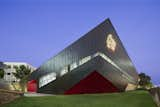40 more photos
Details
Credits
From Thirdspace Architecture Studio
Can a structure embody dual personas - seamlessly integrating into its surroundings while also commanding attention? Can an architectural object be defined by an absence as much as a presence? The Indoor Sports Arena at KLE Technological University grapples with such philosophical inquiries, seeking to reconcile the paradoxes of architecture, landscape, and urban identity.
Sited within one of the last remaining green tracts of a 100-acre university campus, the building occupies a residual space that abuts a major six-lane arterial road. The site thus embodies a duality — on one side, the intensity of the city’s vehicular movement; on the other, the serenity of the campus with its rolling greens and scattered institutional buildings.
This polarity extended to the institutional vision as well. The Chancellor expressed concern over the loss of open green space and the obstruction of visual porosity from the city into the campus. In contrast, the Vice Chancellor advocated for a strategically assertive architectural gesture that could establish a clear identity for the university within the city fabric — particularly as the building was envisioned as a commemorative structure marking 75 years of the institution. These two perspectives — one emphasizing withdrawal and landscape preservation, the other visibility and civic presence — became the generative tension from which the design emerged.
Topographically, the site presented a subtle but critical sectional shift: the arterial road lay approximately four metres below the rising campus terrain. This natural gradient offered a strategic opportunity — the building could sink into the ground from the campus side, preserving the continuity of landscape, while simultaneously emerging as an urban artifact along the city edge.
The internal programme, governed by the exacting spatial requirements of indoor sports — particularly basketball and badminton — necessitated large, volumetric enclosures. Rather than allow these volumes to dominate the site, they are partially submerged, enabling the landscape to flow over and around them. This decision allows the building to recede into the background from the campus side, its peripheral green roofs blurring the edge between architecture and terrain.
The heart of the arena is formed by the basketball and badminton courts — programmatic anchors that necessitate long spans and significant vertical clearance. These are configured as a central court flanked by ancillary spaces — changing rooms, restrooms, and support functions — and spectator galleries on either side, accommodating up to 1,300 spectators. The central courts are designed to transform into a convocation hall with a capacity of 3,500, reflecting the multifunctional intent of the building. A pyramidal steel roof spans this space, while the peripheral volumes dissolve into a landscape roofscape, embedding the structure into its context.
Three major access points — plazas to the east, west, and north — negotiate the existing contours and tree canopies, functioning as social condensers that extend campus life to the building’s threshold and even onto its surface. These are not merely circulation spaces but architectural gestures that knit the building into the fabric of campus life.
From within, the structure reads as an introverted interior-scape — purpose-built for focused athletic activity. From the outside, it engages with the ground plane and becomes an extension of the campus’s landscape and spatial order. The building thus performs a dual function: a utilitarian envelope for competitive sport and a civic surface for everyday inhabitation.
Rejecting the typological isolation of conventional sports facilities, which often serve only their athletic users, this building reimagines itself as a public terrain. Gardens, paths, and plazas are deployed not as adjuncts but as primary architectural moves — elements that dissolve the boundary between building and site.
From the city, the arena asserts a bold tectonic identity. Zinc cladding and glass form a taut, angular envelope that emerges from the earth and rises, seemingly weightless, towards the west. At this corner, the building lifts to reveal a deep red soffit, forming an inviting, shaded interstitial space — a gesture of levity and openness within an otherwise imposing form.
The zinc surfaces, dark and reflective, respond to changing light, animating the form throughout the day. The interior, by contrast, introduces playful insertions of colour — especially red — that accentuate thresholds and undercrofts, offering glimpses into the building’s more spirited interiority.
Ultimately, the Indoor Sports Arena exists as a paradoxical object: embedded and emergent, assertive and recessive, civic and campus-oriented. It does not resolve contradictions but rather inhabits them, revealing a complexity that is both spatial and conceptual. In doing so, it becomes more than a sports facility. It becomes a spatial proposition about how buildings can mediate between landscape and city, between programmatic specificity and public generosity.



















